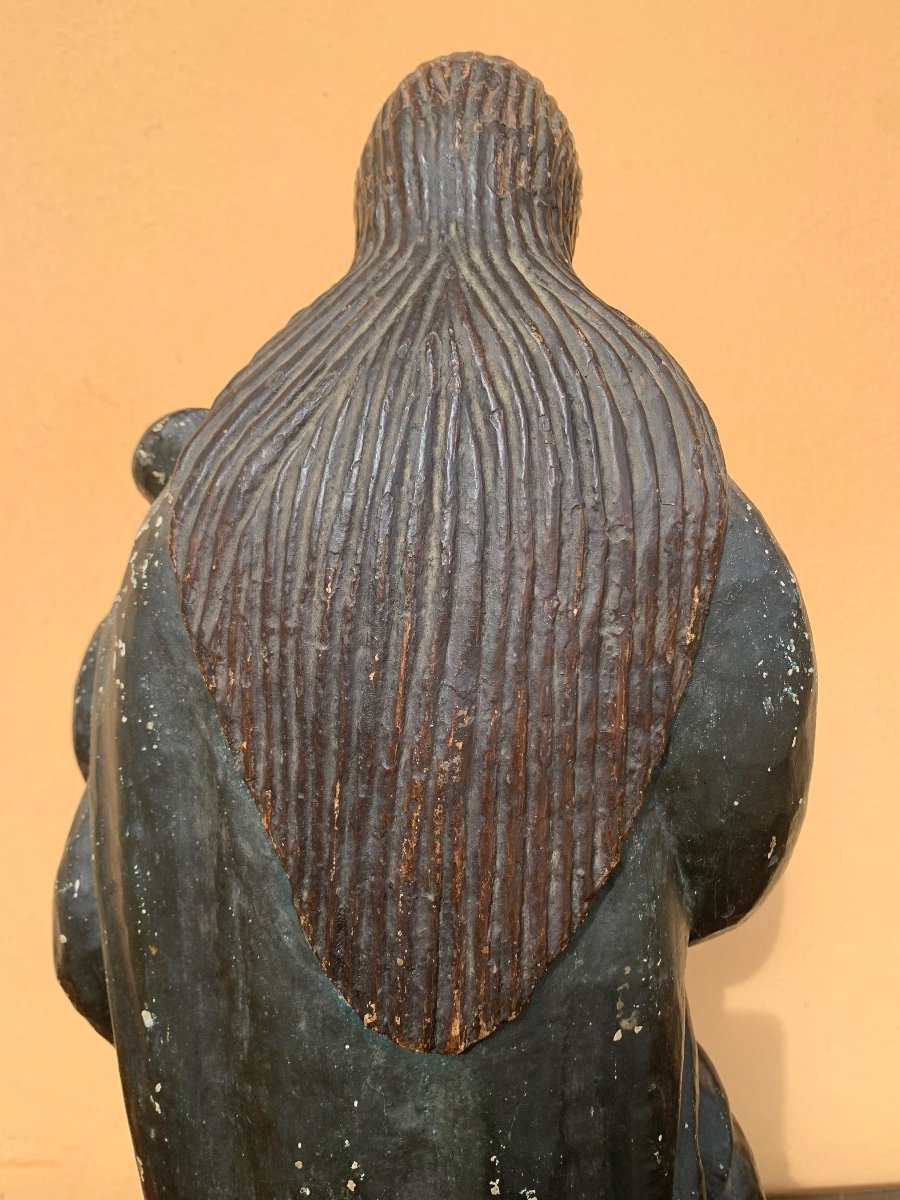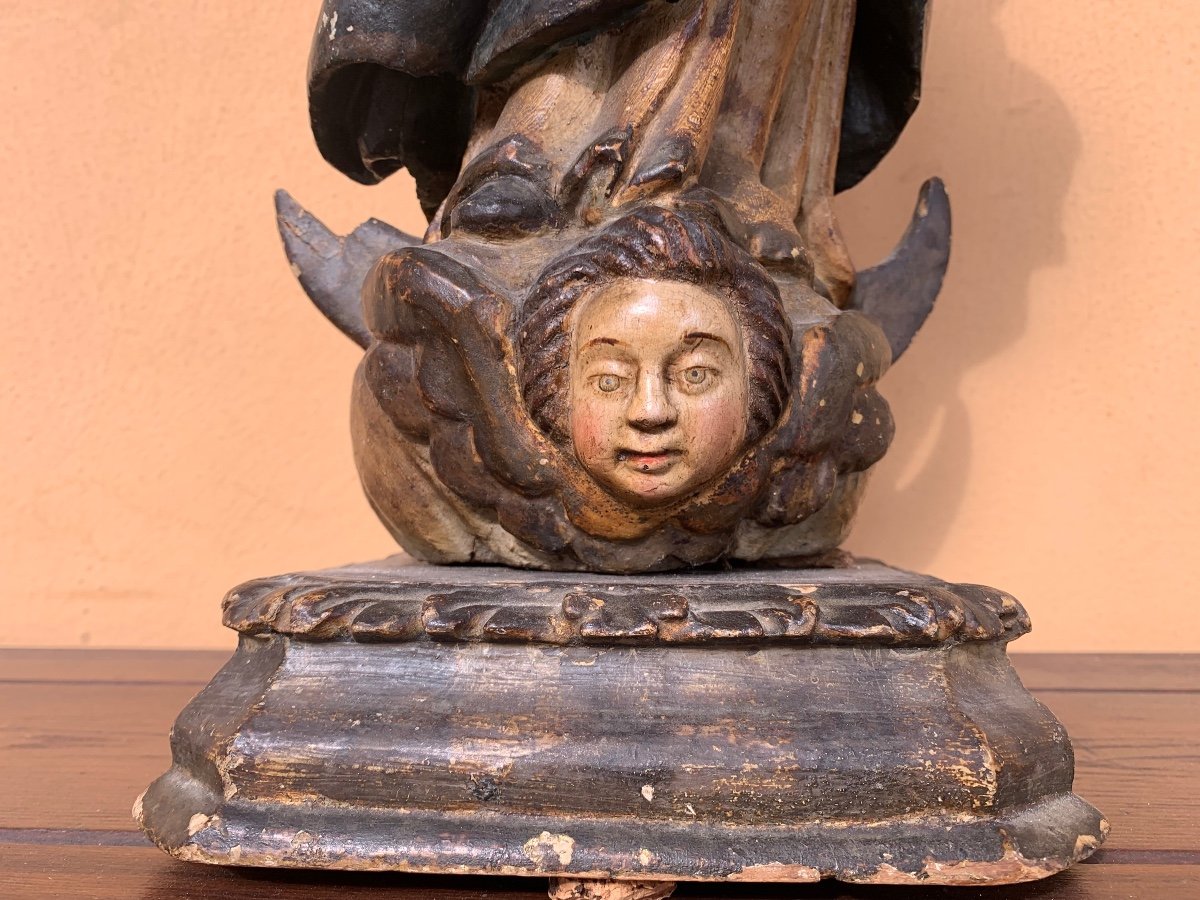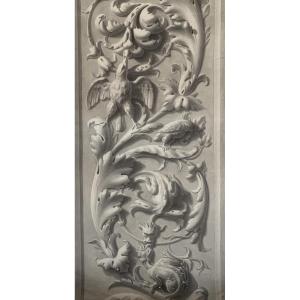Period: 17th-18th century
Dimensions:
- Height: approximately 51 cm
- Width: approximately 21 cm
- Depth: approximately 16 cm
Carved and polychrome wood
Immaculate Virgin, Colonial Baroque Art
Period: 17th-18th century
- Height: approximately 51 cm
- Width: approximately 21 cm
Depth: approximately 16 cm
Material: Carved and polychrome wood
Condition:
- Overall in good condition.
- A small missing part on the crescent moon beneath the feet of the figure.
- Slight signs of aging on the polychromy, especially on the back, visible on the hair and mantle.
The sculpture represents the Immaculate Virgin, traditionally associated with purity and the absence of original sin. The figure is carved with hands joined in prayer, wrapped in a dark mantle that creates a fluid and enveloping movement, typical of the Baroque style, with dynamism reflected in the drapery. The face is serene, with delicate features that convey a deep inner peace.
The particularity of the sculpture lies in the hair, carefully crafted and divided into defined locks, a distinctive detail of colonial art, found in works produced in the Americas, especially in countries like Peru and Mexico, under Spanish influence. Beneath the feet of the Virgin is a winged cherub, a recurring motif in representations of the Immaculate Conception, highlighting victory over original sin.
The iconography of the Immaculate Conception follows the description of the Catholic dogma, with the Virgin placed on a crescent moon, symbolizing her purity and celestial ascension. The cherub beneath her feet is a clear reference to triumph over evil and divine protection. The representation of the Virgin above the moon and with the cherub’s head is a distinctive feature of this Marian iconography, inspired by the Book of Revelation (12:1).
The hair, sculpted into detailed locks, is a distinctive feature of South American colonial style, particularly in the Andean region, influenced by Spanish art. This characteristic is often found in colonial Marian sculptures, especially in the art of the Cuzco school (Peru) and in Mexico, where the image of the Immaculate was particularly venerated.
The sculpture may originate from the Americas, perhaps from Peru or Mexico, where colonial Baroque art produced numerous representations of the Immaculate Virgin, with similar details in the hair and facial features. The schools of Cuzco and Quito are particularly known for producing finely detailed wooden Marian sculptures.
**Venerated Subject:**
The Immaculate Conception is one of the most venerated figures in the Catholic world, with different versions of the Virgin venerated in countries such as Spain and its colonies. One example is the “Virgen de la Inmaculada Concepción” venerated in Lima, Peru, and in other cities across Latin America.
- Overall in good condition.
- A small missing part on the crescent moon beneath the feet of the figure.
- Slight signs of aging on the polychromy, especially on the back, visible on the hair and mantle.
The sculpture represents the Immaculate Virgin, traditionally associated with purity and the absence of original sin. The figure is carved with hands joined in prayer, wrapped in a dark mantle that creates a fluid and enveloping movement, typical of the Baroque style, with dynamism reflected in the drapery. The face is serene, with delicate features that convey a deep inner peace.
The particularity of the sculpture lies in the hair, carefully crafted and divided into defined locks, a distinctive detail of colonial art, found in works produced in the Americas, especially in countries like Peru and Mexico, under Spanish influence. Beneath the feet of the Virgin is a winged cherub, a recurring motif in representations of the Immaculate Conception, highlighting victory over original sin.
The iconography of the Immaculate Conception follows the description of the Catholic dogma, with the Virgin placed on a crescent moon, symbolizing her purity and celestial ascension. The cherub beneath her feet is a clear reference to triumph over evil and divine protection. The representation of the Virgin above the moon and with the cherub’s head is a distinctive feature of this Marian iconography, inspired by the Book of Revelation (12:1).
The hair, sculpted into detailed locks, is a distinctive feature of South American colonial style, particularly in the Andean region, influenced by Spanish art. This characteristic is often found in colonial Marian sculptures, especially in the art of the Cuzco school (Peru) and in Mexico, where the image of the Immaculate was particularly venerated.
The sculpture may originate from the Americas, perhaps from Peru or Mexico, where colonial Baroque art produced numerous representations of the Immaculate Virgin, with similar details in the hair and facial features. The schools of Cuzco and Quito are particularly known for producing finely detailed wooden Marian sculptures.
The Immaculate Conception is one of the most venerated figures in the Catholic world, with different versions of the Virgin venerated in countries such as Spain and its colonies. One example is the “Virgen de la Inmaculada Concepción” venerated in Lima, Peru, and in other cities across Latin America.


















































 Le Magazine de PROANTIC
Le Magazine de PROANTIC TRÉSORS Magazine
TRÉSORS Magazine Rivista Artiquariato
Rivista Artiquariato